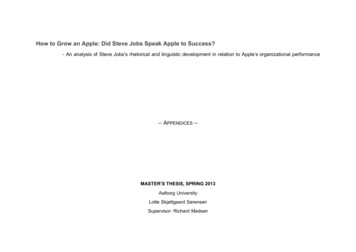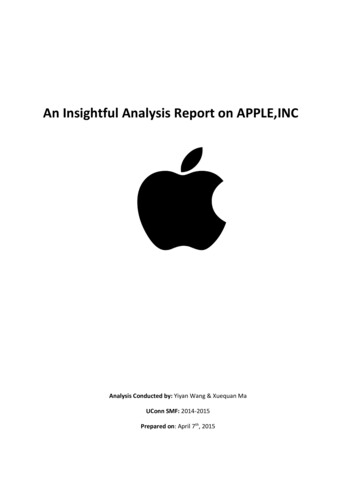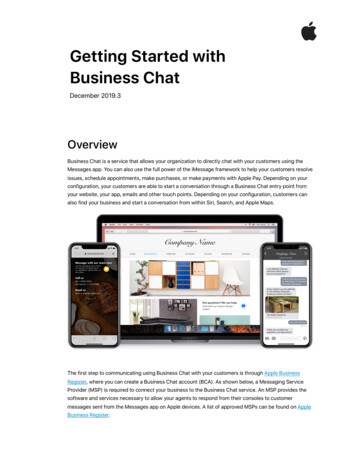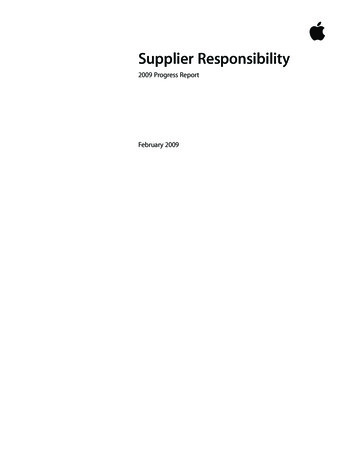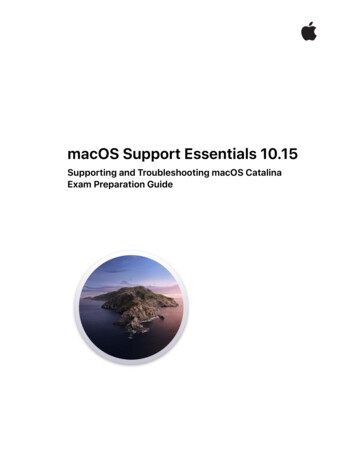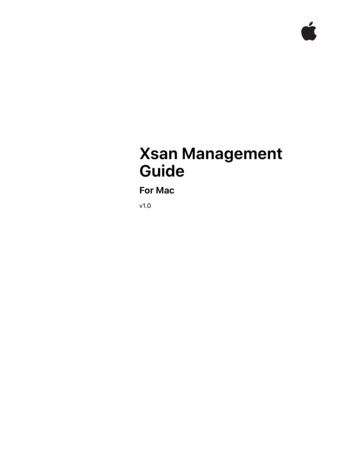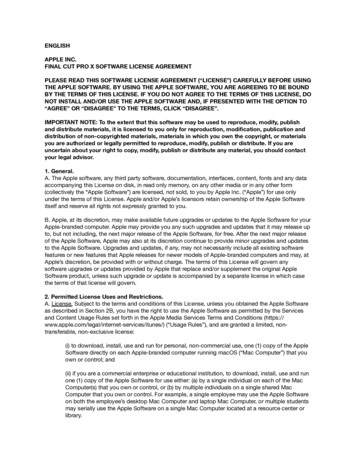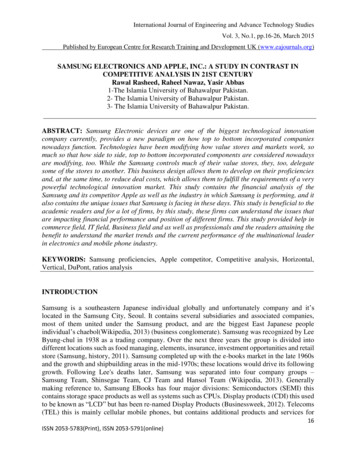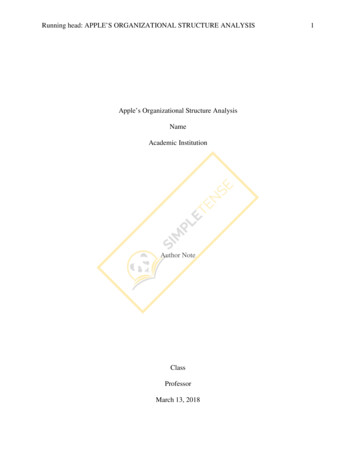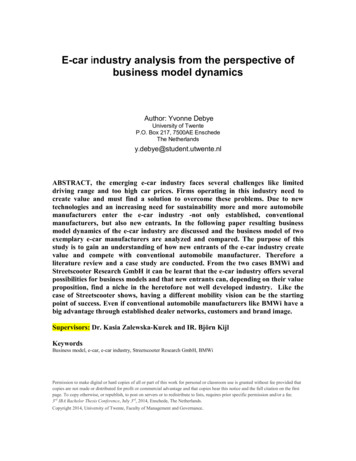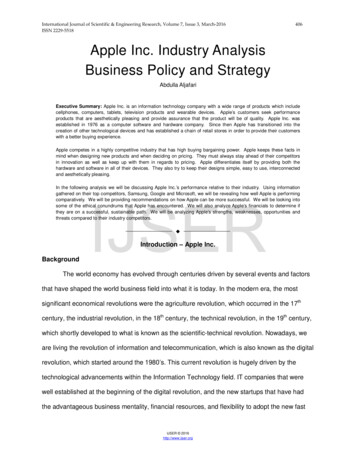
Transcription
International Journal of Scientific & Engineering Research, Volume 7, Issue 3, March-2016ISSN 2229-5518406Apple Inc. Industry AnalysisBusiness Policy and StrategyAbdulla AljafariExecutive Summary: Apple Inc. is an information technology company with a wide range of products which includecellphones, computers, tablets, television products and wearable devices. Apple’s customers seek performanceproducts that are aesthetically pleasing and provide assurance that the product will be of quality. Apple Inc. wasestablished in 1976 as a computer software and hardware company. Since then Apple has transitioned into thecreation of other technological devices and has established a chain of retail stores in order to provide their customerswith a better buying experience.Apple competes in a highly competitive industry that has high buying bargaining power. Apple keeps these facts inmind when designing new products and when deciding on pricing. They must always stay ahead of their competitorsin innovation as well as keep up with them in regards to pricing. Apple differentiates itself by providing both thehardware and software in all of their devices. They also try to keep their designs simple, easy to use, interconnectedand aesthetically pleasing.In the following analysis we will be discussing Apple Inc.’s performance relative to their industry. Using informationgathered on their top competitors, Samsung, Google and Microsoft, we will be revealing how well Apple is performingcomparatively. We will be providing recommendations on how Apple can be more successful. We will be looking intosome of the ethical conundrums that Apple has encountered. We will also analyze Apple’s financials to determine ifthey are on a successful, sustainable path. We will be analyzing Apple’s strengths, weaknesses, opportunities andthreats compared to their industry competitors.IJSER—————————— ——————————Introduction – Apple Inc.BackgroundThe world economy has evolved through centuries driven by several events and factorsthat have shaped the world business field into what it is today. In the modern era, the mostsignificant economical revolutions were the agriculture revolution, which occurred in the 17thcentury, the industrial revolution, in the 18th century, the technical revolution, in the 19th century,which shortly developed to what is known as the scientific-technical revolution. Nowadays, weare living the revolution of information and telecommunication, which is also known as the digitalrevolution, which started around the 1980’s. This current revolution is hugely driven by thetechnological advancements within the Information Technology field. IT companies that werewell established at the beginning of the digital revolution, and the new startups that have hadthe advantageous business mentality, financial resources, and flexibility to adopt the new fastIJSER 2016http://www.ijser.org
International Journal of Scientific & Engineering Research, Volume 7, Issue 3, March-2016ISSN 2229-5518407pace advancements that were taking place within the electronics field, grew up massively withina few decades and became major players nowadays, not in their field alone, but overall in theworld economy.In this case study, the focus will be on Apple, the world largest publicly traded companyby market capitalization with current estimated value of US 530 billion and the second largestmobile phone manufacturer in the world (Booton, 2016). Apple is an American company basedin Cupertino, CA, that is solely focused on manufacturing and selling consumer electronics,software programs and online services (Apple Reports, 2005). Its products include, but are notlimited to, cell phones, media players, tablets, computers, computer applications and operatingsystems.IJSERThe company was established by Steve Jobs, Steve Wozniak and Ronald Wayne as asmall personal computer manufacturer and its first product was hand made by Wozniak himselfand was called Apple I (Apple History, 2015). Wayne sold his share a year after for US 800 atthe same time an investor named Mike Markkula became part of the company and helped Applewith the business expenses needed to expand and invested US 250,000 in Apple (AppleHistory, 2015). The company’s revenues were growing at an exponential rate and doublingevery four months for the first five years (Apple History, 2015). Apple kept growing andintroduced new versions of its computer in 1977 and 1980 hoping to compete in the corporatecomputers field. By the end of 1980, Apple went public and its shares were offered in the stockmarket for US 22 a share (Apple History, 2015).Apple launched the Macintosh in 1984, which sold well at the beginning, but failed togrow or even maintain the sales numbers few months after (Apple History, 2015). Its high retailprice and limited use due to lack of software options were the reason behind this failure (AppleHistory, 2015). This all changed with the introduction of LaserWriter and PageMaker, anaffordable printer and publishing software that, when combined with Macintosh capabilities,becomes highly appealing for businesses, writers and publishers (Apple History, 2015).IJSER 2016http://www.ijser.org
International Journal of Scientific & Engineering Research, Volume 7, Issue 3, March-2016ISSN 2229-5518408A year after, Jobs got into a power related conflict with the CEO at that time, JohnSculley (Apple History, 2015). This led to Jobs leaving the company and selling all of his sharesin Apple, except one, for US 70 million. Jobs established his own company called NeXT whichhad a focus of software programing (Apple History, 2015). At that same time, Sculley had astrategy of implementing a 55% profit margin on Apple products (Apple History, 2015). Thisstrategy failed as soon as PC’s came out having similar capabilities as the Macintosh and soldfor a fraction of Macintosh’s retail price (Apple History, 2015). Apple faced a huge loses at thattime and went back into the shadow (Apple History, 2015). To get over this loss, Apple decidedto get back the share it lost to Microsoft and the PC market by working together with IBM andMotorola to bring a new platform to the market (Apple History, 2015). It also launched an emailIJSERplatform called eWorld, which was part of its business diversifying strategy (Apple History,2015).In 1996, NeXT won a bid to provide an operating system firmware to Apple (AppleHistory, 2015). NeXT was acquired shortly thereafter that and Steve Jobs was able to make hisway back into Apple (Apple History, 2015). A year after his return, he was appointed interimCEO and became permanent four years after. Jobs’ return was a company changing momentfor Apple due to the new philosophy that he implemented, which consists of simple design andunique products (Apple History, 2015).In 1997, Bill Gates, Microsoft CEO, and Steve Jobs decided to settle a long-term legalbattle regarding patent infringement by bringing the office suite to Apple computers, makinginternet explorer the default browser on all Apple computers and having Microsoft invest 150million in the Apple (Arthur, 2011). Apple used this investment to bringing more creativecontents to its products and investing in the education market (Apple History, 2015). Thiseventually led to the introduction of the iMac, an all-new computer with an attractive design of amulticolor see-through plastic shell (Apple History, 2015). Apple sales of the iMac averaged toIJSER 2016http://www.ijser.org
International Journal of Scientific & Engineering Research, Volume 7, Issue 3, March-2016ISSN 2229-5518409about 1 million units a year and it announced a strong return to the computers market (AppleHistory, 2015).The year 2001 was full of major events for Apple. It started with introducing the MacOSX, an all-new user-friendly computer firmware that was a revolution at its time due to itsstability, quality of graphics used in the interface, and it brought the well-known high securitylevel of Unix operating systems to Apple computers (Apple History, 2015). Later in May of thatyear, Apple announced opening a chain of retail stores to assist in establishing a directconnection with its customers, and better marketing for its products due to the dissatisfaction ofhow third-party retailers presented Apple products (Apple History, 2015). The major event inthat year was announced in October and it was the introduction of the iPod, a digital musicIJSERplayer (Apple History, 2015). The iPod had smashing sales and took Apple’s total revenue from 1.9 billion dollars in the first quarter of 2000 to 3.2 billion dollars in the same quarter of 2001(Apple History, 2015). Three years after, Apple announced that it had 76% of the music playermarket. In order to supply the demand for digital music tracks, Apple introduced the iTunesstore, a digital media library focused on music (Apple History, 2015). Apple was able to sell atotal of 1 billion songs on iTunes in just three years after its launch, and a grand total of 10billion songs by early 2010 (Apple History, 2015).In 2007 Apple entered the cellphone market by introducing the iPhone, which was highlyadmired due to its unique style, touch screen capability and lack of physical keyboard (AppleHistory, 2015). The iPhone was followed by the iPad in 2010, which was simply a bigger iPhonewithout the calling capabilities, targeting people who are looking for lightweight devices with bigscreens that can do most of the tasks they can do on their computers (Apple History, 2015).Later on 2010, a significant historical moment occurred (Apple History, 2015). Apple’s mostimportant rival and the longtime dominant of the computers market, Microsoft, lost its position inregards to stock value and revenue when Apple stock market value and total revenuesurpassed Microsoft for the first time ever (Apple History, 2015). This was far from expectationsIJSER 2016http://www.ijser.org
International Journal of Scientific & Engineering Research, Volume 7, Issue 3, March-2016ISSN 2229-5518410back in the 80’s and 90’s, but due to Apple continued success in several markets especially thecellphone market while Microsoft was failing in several business fields especially in its onlinesearch engine business, it became possible (Apple History, 2015). Apple’s success continued,even after its success maker Steve Jobs’ departure in 2011 and Tim Cook taking his place, bycontinuing to develop its current products and introducing new products like the most recentApple Watch (Apple History, 2015).VisionApple, Inc.’s vision, as found on their website, is “Apple is committed to bringing the bestpersonal computing experience to students, educators, creative professionals and consumersaround the world through its innovative hardware, software, and Internet offerings”MissionIJSERApple, Inc.’s mission is stated on their company website and is the following: Appledesigns Macs, the best personal computers in the world, along with OS X, iLife, iWork andprofessional software. Apple leads the digital music revolution with its iPods and iTunes onlinestore. Apple has reinvented the mobile phone with its revolutionary iPhone and App Store, andis defining the future of mobile media and computing devices with iPadValuesApple, Inc.’s values can also be obtained from their company website and include thefollowing factors: We believe that we’re on the face of the Earth to make great products. Webelieve in the simple, not the complex. We believe that we need to own and control the primarytechnologies behind the products we make. We participate only in markets where we can makea significant contribution. We believe in saying no to thousands of projects so that we can reallyfocus on the few that are truly important and meaningful to us. We believe in deep collaborationand cross-pollination of our groups, which allow us to innovate in a way that others cannot. Wedon’t settle for anything less than excellence in every group in the company, and we have theself-honesty to admit when we’re wrong and courage to change.IJSER 2016http://www.ijser.org
International Journal of Scientific & Engineering Research, Volume 7, Issue 3, March-2016ISSN 2229-5518411Business StrategyApple Inc. has a clearly stated business strategy that can be found in their annual 10-Kreports. Their business strategy is as follows: The Company is committed to bringing the bestuser experience to its customers through its innovative hardware, software, peripherals, andservices. The Company’s business strategy leverages its unique ability to design and developits own operating systems, hardware, application software, and services to provide itscustomers new products and solutions with superior ease-of-use, seamless integration, andinnovative design. The company believes continual investment in research and developmentand marketing and advertising is critical to the development and sale of innovative products andtechnologies. As part of its strategy, the Company continues to expand its platform for theIJSERdiscovery and delivery of third-party digital content and applications through the iTunes Store.As part of the iTunes Store, the company’s App Store and iBook store allow customers todiscover and download applications and books through either a Mac or Windows-basedcomputer or through “iOS devices,” namely iPhone, iPad and iPod touch. In January 2011, theCompany opened the Mac App Store to allow customers to easily discover, download andinstall applications for their Macs. The company also supports a The Innovative Success that isApple, Inc. 4 community for the development of third-party software and hardware products anddigital content that complement the Company’s offerings. The Company’s strategy also includesexpanding its distribution network to effectively reach more customers and provide them with ahigh-quality sales and post-sales support experience.” (Apple Inc., 2015). The mission, vision,strategy and goals define decision mak
Apple, Inc.’s mission is stated on their company website and is the following: Apple designs Macs, the best personal computers in the world, along with OS X, iLife, iWork and professional software. Apple leads the digital music revolution with its iPods and iTunes online store. Apple has reinvented the mobile phone with its revolutionary iPhone and App Store, and
